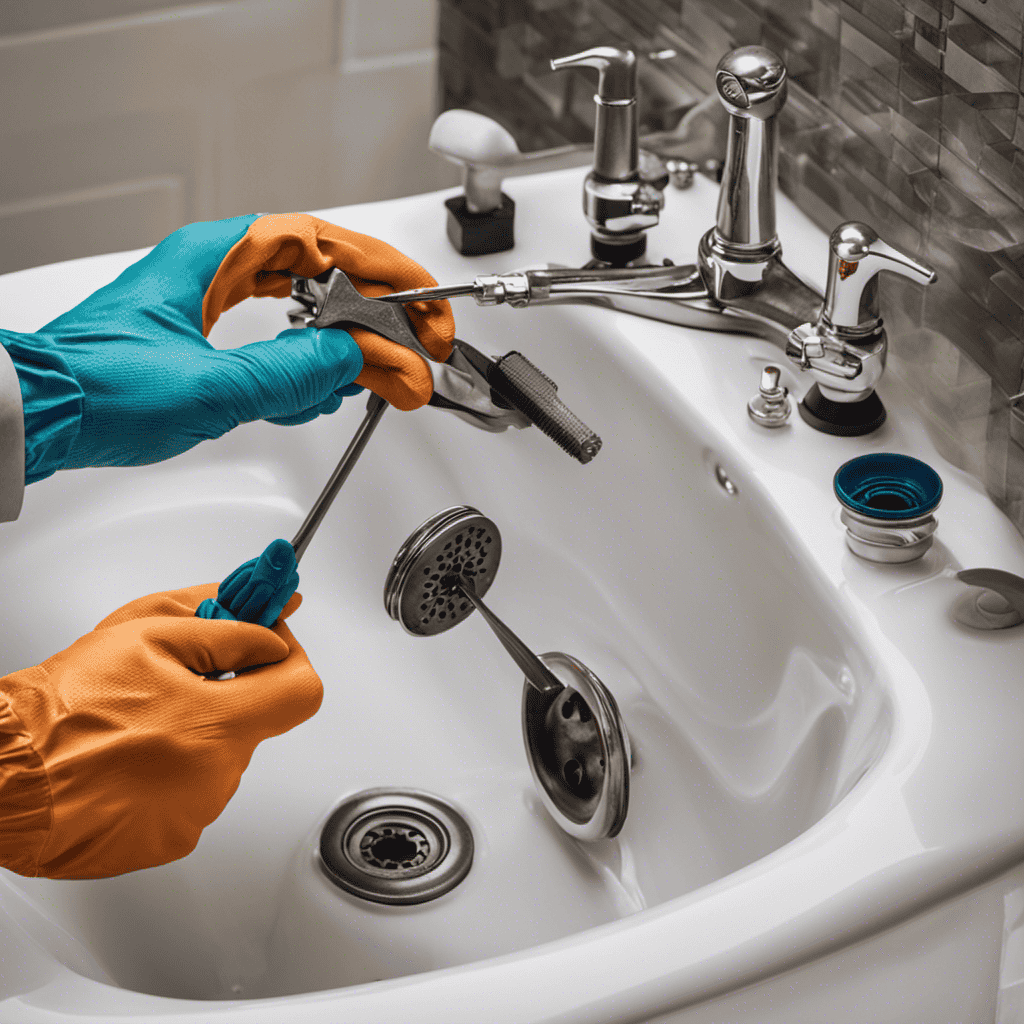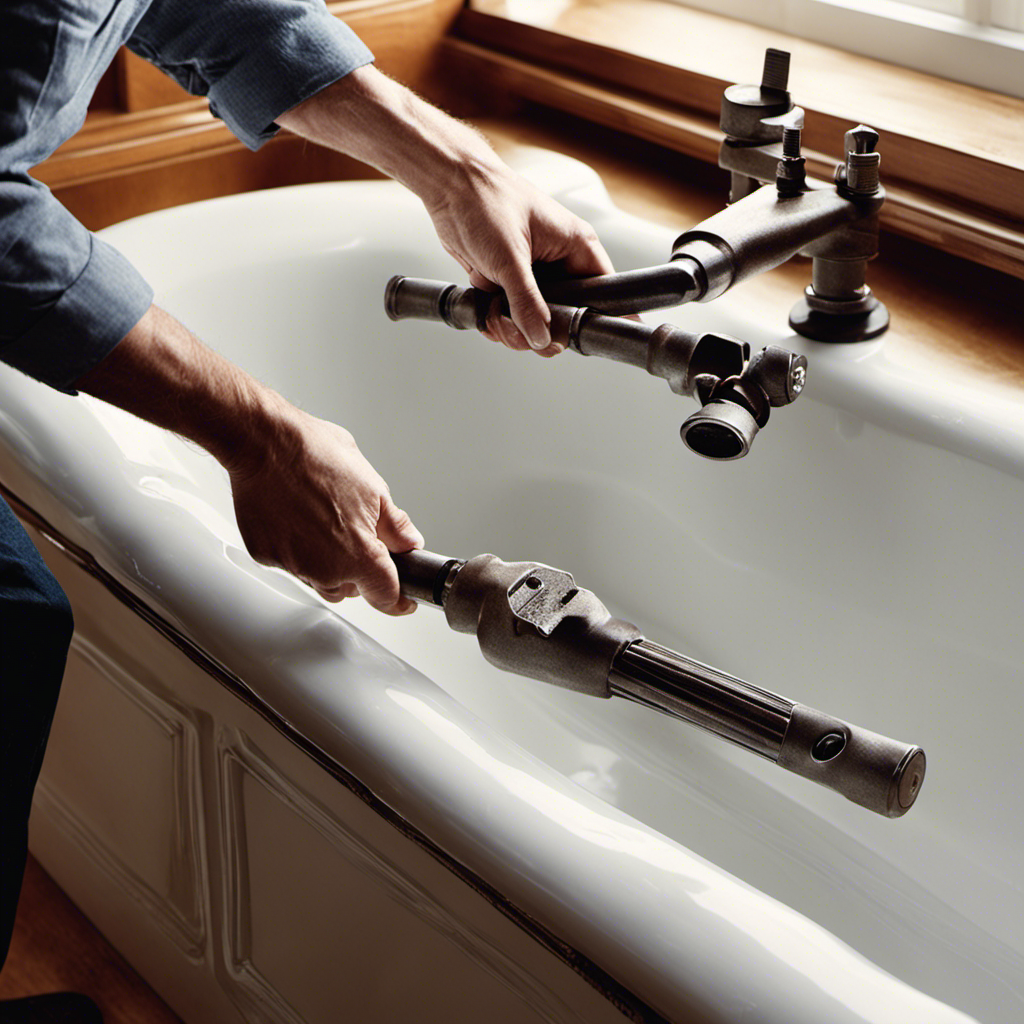I’ve got a tried and true method for unclogging a bathtub drain that I’m eager to share with you. Say goodbye to slow drains and standing water with just a few simple steps.
In this article, I’ll walk you through the common causes of bathtub drain clogs, the tools and materials you’ll need, and a step-by-step guide to get your drain flowing smoothly again.
Plus, I’ll share some natural remedies and tips for preventing future clogs. Let’s dive in and get that drain unclogged once and for all!
Key Takeaways
- Accumulation of hair and soap residue can cause bathtub drain clogs.
- Plungers and drain snakes are effective tools for unclogging bathtub drains.
- Natural remedies such as baking soda and vinegar can help dissolve stubborn clogs.
- Regular maintenance and prevention methods can help prevent future bathtub drain clogs.
Common Causes of Bathtub Drain Clogs
One of the most common causes of bathtub drain clogs is the accumulation of hair and soap residue. Over time, as we shower or bathe, strands of hair can get caught in the drain, creating a blockage. Additionally, soap residue can build up and combine with the hair, further obstructing the flow of water.
It is important to be aware of the signs of a clogged bathtub drain, such as slow draining water, standing water in the tub, or a foul odor coming from the drain. To prevent bathtub drain clogs, it is recommended to use a drain cover or strainer to catch hair and debris, regularly clean the drain with a mixture of hot water and vinegar, and avoid pouring grease or oil down the drain.
Taking these preventative measures can help keep your bathtub drain clear and functioning properly.
Tools and Materials You’ll Need
To get started, you’ll need a few tools and materials. When it comes to unclogging a bathtub drain, having the right equipment is essential.
Here are the items you’ll need: a plunger, a drain snake or auger, a bucket, rubber gloves, and a flashlight.
The plunger is an effective tool for dislodging clogs that are closer to the surface. For deeper clogs, a drain snake or auger can be used to reach and remove the blockage.
It’s important to wear rubber gloves to protect your hands from any debris or chemicals you may encounter. And don’t forget a bucket to catch any water that may come out during the unclogging process.
While these tools can be helpful, it’s important to note that more serious clogs may require professional assistance. If you’re not confident in your plumbing techniques or if the clog persists, it’s best to call in a professional plumber who can resolve the issue safely and effectively.
Step-by-Step Guide to Unclogging a Bathtub Drain
Start by gathering the necessary tools and materials mentioned earlier, such as a plunger, drain snake or auger, bucket, rubber gloves, and flashlight.
Now that you have everything you need, it’s time to tackle the task of unclogging your bathtub drain. Before reaching for chemical drain cleaners, it’s important to note that they can be harsh on your pipes and may not always be effective. Instead, consider trying a plunger first. Place it over the drain, ensuring a tight seal, and give it a few forceful pushes and pulls.
If that doesn’t work, you can try using a drain snake or auger to manually remove the clog. Remember to always wear rubber gloves to protect your hands.
If all else fails, it may be necessary to hire a professional plumber who has the experience and tools to handle stubborn clogs effectively and safely.
Natural Remedies for Stubborn Clogs
If you’re dealing with a stubborn clog, you can try using natural remedies instead of harsh chemical cleaners. Chemical free solutions for unclogging bathtub drains are not only safer for the environment but also gentler on your plumbing system.
One DIY technique for removing stubborn bathtub clogs is to use a mixture of baking soda and vinegar. Start by pouring half a cup of baking soda down the drain, followed by half a cup of vinegar. Let it sit for about 30 minutes, then flush it with hot water.
Another option is to use a combination of salt and baking soda. Mix equal parts of salt and baking soda, then pour it down the drain. Let it sit for a few hours, then rinse it out with hot water.
These natural remedies can help break down the clog and clear your bathtub drain without the use of harsh chemicals.
Tips for Preventing Future Bathtub Drain Clogs
One way you can prevent future clogs in your bathtub is by using a drain cover to catch hair and other debris. This simple solution can save you from the hassle of dealing with a clogged drain in the future.
However, there are other important steps you can take to maintain your bathtub drain and avoid clogs. Here are some tips for bathtub drain maintenance:
-
Regularly clean the drain cover: Hair and soap scum can accumulate on the drain cover, leading to clogs. Cleaning it regularly will prevent this build-up.
-
Use a drain snake: A drain snake is a handy tool that can effectively remove hair and other debris from your drain. Use it once a month to keep your drain clear.
-
Avoid pouring grease down the drain: Grease can solidify and block your drain. Dispose of it in a separate container instead.
-
Consider professional drain cleaning: If you’re experiencing persistent clogs or slow drainage, it may be time to call a professional drain cleaning service. They have the expertise and tools to thoroughly clean your drain and prevent future clogs.
Conclusion
So there you have it, folks. After all the work, sweat, and frustration, your bathtub drain is finally unclogged. It’s a moment of triumph, a victory over the forces of hair, soap scum, and whatever else was lurking down there.
You can almost hear the drain whispering its thanks as the water flows freely once again. But don’t get too comfortable, because you know deep down that it’s only a matter of time before the clog returns, ready to challenge your unclogging skills once more.
So enjoy the victory while it lasts, my friends, because the battle of the bathtub drain is never truly over.










